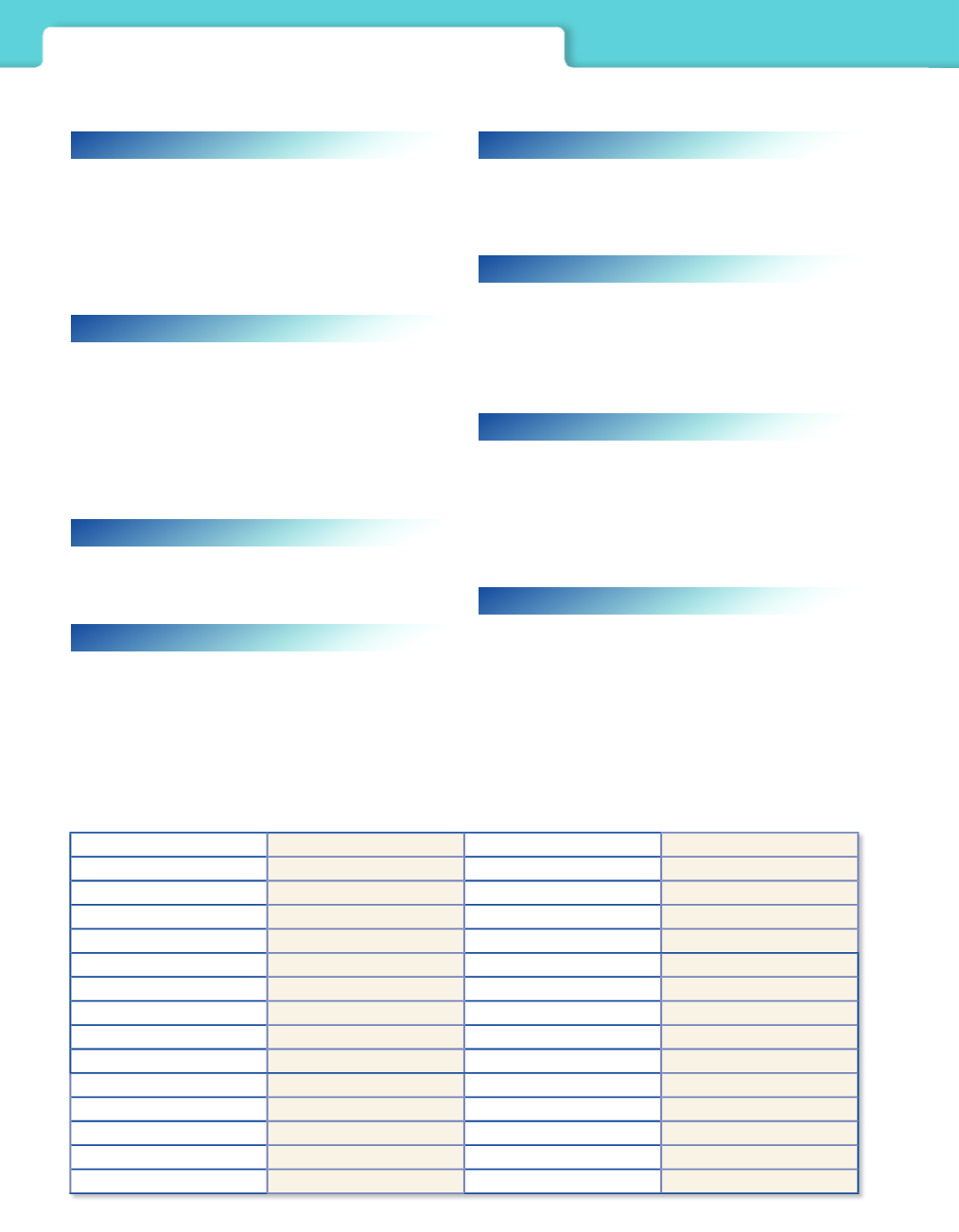
5. Prepositions
Describe relationships between words in a sentence.
Words:
to, at, after, on, but across, toward, up, down, in,
under, over, against, during, for
Example:
The ball landed
between
the house and the river.
6. Conjunctions
Connect words, phrases, or clauses together.
Coordinating Conjunctions
join elements of the same
value words:
F
or
A
nd
N
or
B
ut
O
r
Y
et
S
o (
FANBOYS
)
Subordinating Conjunctions
connect main clauses and
dependent clauses: if, so because, when, after, whereas
7. Adjectives
Describe nouns or pronouns.
Sometimes referred to as
the modifier
, adjectives can
describe things such as size, color, number, etc.
Answers the questions:
What kind? What type? Which one? How much? How many?
Example:
The
small
toy made the boy happy.
8. Interjections
The independent sudden use of a word to express strong
emotion, summon attention or surprise. (They are often
followed by an exclamation mark.)
Oh!, Ouch!, Hi!, Whoa!
Example: Ouch!
A bug just bit me.
1. Nouns
Describe people, places, things, events, ideas, etc.
There are different types of nouns:
Common Nouns
refer to places, people, ideas, or things.
Example:
ocean, book, storm
Proper Nouns
refer to particular people, places, or things.
Example:
Massachusetts, Adam
2. Pronouns
Used to replace nouns, modifiers, or other pronouns.
Nominative Case:
for the subject of a sentence or clause.
Example:
they, he, she
Possessive Case:
shows ownership.
Example:
his, hers
Objective Case:
receives action, or is after a preposition.
Example:
They sold
him
a damaged book.
3. Verbs
Show actions, states of being, or events.
Example words:
(to) be, have, do, like, work, sing,
can, must, walk (walked, will walk)
4. Adverbs
Used to describe verbs, adjectives, or other adverbs.
Usually end in -ly.
Answer five questions:
What, Where, How, Why andWhen.
Example:
She worked
quickly
to finish her assignment.
(“Quickly” describes the verb “worked.”)
ENGLISH
Common Contractions
I will
I'll
is not
isn't
I am
I'm
are not
aren't
I would
I'd
was not
wasn't
I have
I've
were not
weren't
I had
I'd
have not
haven't
You will
You'll
has not
hasn't
You are
You're
had not
hadn't
You would
You'd
will not
won't
You have
You've
would not
wouldn't
You had
You'd
do not
don't
We will
We'll
does not
doesn't
We are
We're
did not
didn't
We would
We'd
can not
can't
We have
We've
could not
couldn't
We had
We'd
should not
shouldn't
Eight Parts of Speech
. re siti s
Describe relationships betwe n words in a sentence.
ords:
to, at, after, on, but acros , toward, up, down, in,
under, over, against, during, for
Exa ple:
The ball anded
betwe n
the house and the river.
.
j cti s
Con ect words, phrases, or clauses together.
Co rdinating Conjunctions
join ele ents of the sa e
value words:
F
or
A
nd
N
or
B
ut
O
r
Y
et
S
o (
FANBOYS
)
Subordinating Conjunctions
con ect main clauses and
dependent clauses: if, so because, when, after, whereas
. jectives
Describe nouns or pronouns.
So etimes refer ed to as
the modifier
, adjectives can
describe things such as size, color, nu ber, etc.
Answers the questions:
hat kind? What ype? Which one? How much? How many?
Exa ple:
The
s al
toy made the boy hap y.
. I terjecti s
The independent sud en use of a word to expres strong
e otion, su on at ention or surprise. (They are often
followed by an excla ation mark.)
Oh!, Ouch!, Hi!, Whoa!
Exa ple: Ouch!
A bug just bit me.
.
s
Describe people, places, things, events, ideas, etc.
There are different ypes of nouns:
Co on Nouns
refer to places, people, ideas, or things.
Exa ple:
ocean, bo k, storm
Proper Nouns
refer to particular people, places, or things.
Exa ple:
Mas achuset s, Ada
. r
s
Used to replace nouns, modifiers, or other pronouns.
No inative Case:
for the subject of a sentence or clause.
Exa ple:
they, he, she
Pos es ive Case:
shows ownership.
Exa ple:
his, hers
Objective Case:
receives action, or is after a preposition.
Exa ple:
They sold
him
a da aged bo k.
. er s
Show actions, states of being, or events.
Exa ple words:
(to) be, have, do, like, work, sing,
can, must, walk (walked, will walk)
. ver s
Used to describe verbs, adjectives, or other adverbs.
Usually end in -ly.
Answer five questions:
hat, Where, How, Why andWhen.
Exa ple:
She worked
quickly
to finish her as ign ent.
(“Quickly” describes the verb “worked.”)
I
t ti s
I wil
I'l
is not
isn't
I a
I'm
are not
aren't
I would
I'd
as not
asn't
I have
I've
ere not
eren't
I had
I'd
have not
haven't
You wil
You'l
has not
hasn't
You are
You're
had not
hadn't
You would
You'd
il not
on't
You have
You've
ould not
ouldn't
You had
You'd
do not
don't
e wil
e'l
does not
doesn't
e are
e're
did not
didn't
e would
e'd
can not
can't
e have
e've
could not
couldn't
e had
e'd
should not
shouldn't
i t
ts f
,
SM-79


